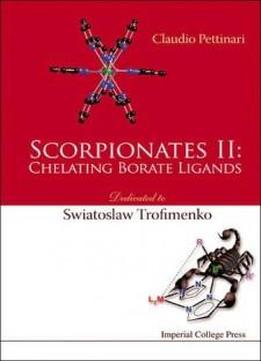
Scorpionates Ii: Chelating Borate Ligands
by Claudio Pettinari /
2008 / English / PDF
10.9 MB Download
Since their discovery by Swiatoslaw Trofimenko in 1967,
poly(pyrazol-1-yl)borates have been considered as one of the most
useful ligands in modern coordination chemistry. The term
scorpionate has been used to describe the interchange between
bidentate and tridentate coordination modes by these ligands that
has been employed for the synthesis of complexes with virtually
every metal in the periodic table, having applications in diverse
fields ranging from homogeneous catalysis to bioinorganic
chemistry.
Since their discovery by Swiatoslaw Trofimenko in 1967,
poly(pyrazol-1-yl)borates have been considered as one of the most
useful ligands in modern coordination chemistry. The term
scorpionate has been used to describe the interchange between
bidentate and tridentate coordination modes by these ligands that
has been employed for the synthesis of complexes with virtually
every metal in the periodic table, having applications in diverse
fields ranging from homogeneous catalysis to bioinorganic
chemistry.
This all-inclusive reference book continues where Trofimenko's
original work left off. It not only includes discussions on all
new ligands reported from 1999 to date, but also introduces new
ligands that have yet to be touched upon in other titles, such as
scorpionates based on S donors or P donors. As such, this
comprehensive volume is a must have for all researchers who
utilize this family of molecules.
This all-inclusive reference book continues where Trofimenko's
original work left off. It not only includes discussions on all
new ligands reported from 1999 to date, but also introduces new
ligands that have yet to be touched upon in other titles, such as
scorpionates based on S donors or P donors. As such, this
comprehensive volume is a must have for all researchers who
utilize this family of molecules.Contents:
Contents: Homoscorpionates -- First Generation;
Homoscorpionates -- Second Generation; Heteroscorpionates;
Scorpionates Based on Thioimidazolones as Sulfur Donors and
Related Ligands; Scorpionates Based on Thioethers as Sulfur
Donors; Scorpionates Based on Diaryl or Dialkylphosphine as
Donors; Application; Concluding Remarks.
Homoscorpionates -- First Generation;
Homoscorpionates -- Second Generation; Heteroscorpionates;
Scorpionates Based on Thioimidazolones as Sulfur Donors and
Related Ligands; Scorpionates Based on Thioethers as Sulfur
Donors; Scorpionates Based on Diaryl or Dialkylphosphine as
Donors; Application; Concluding Remarks.











